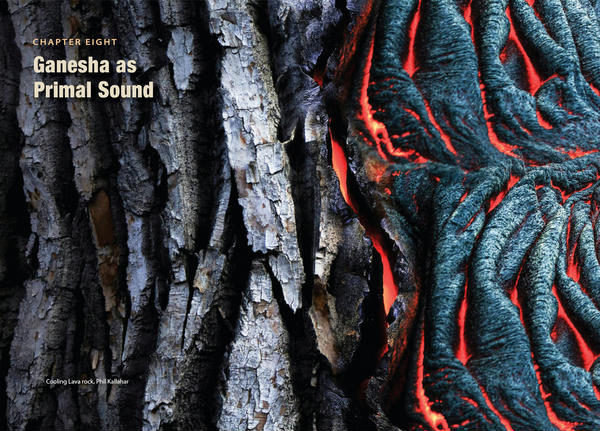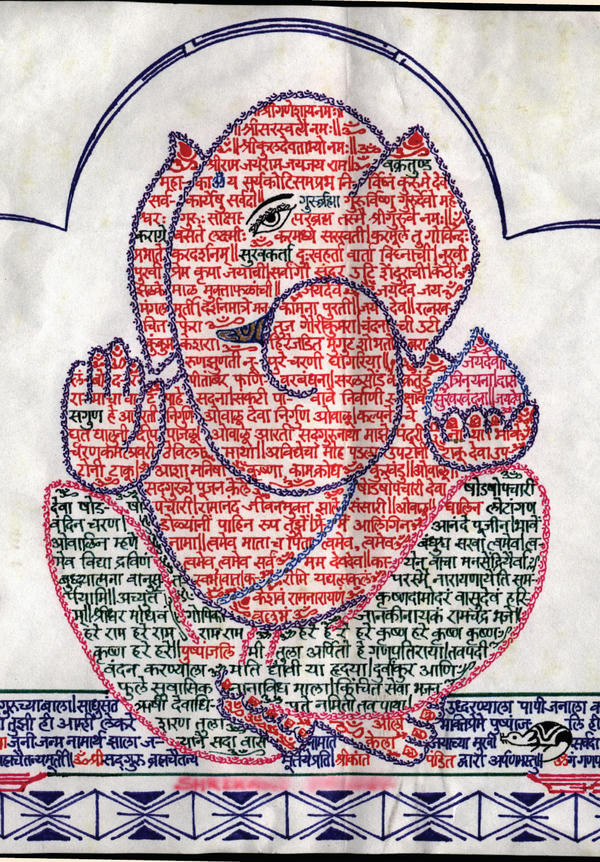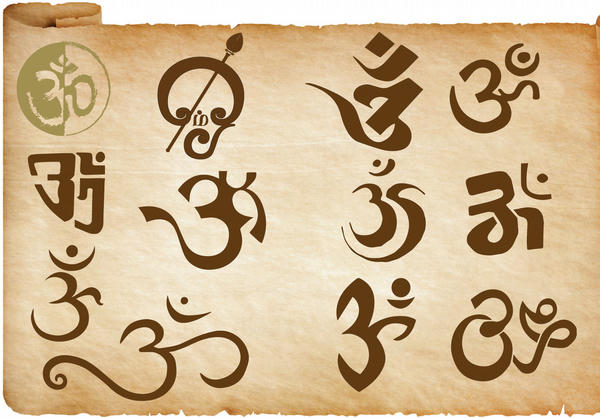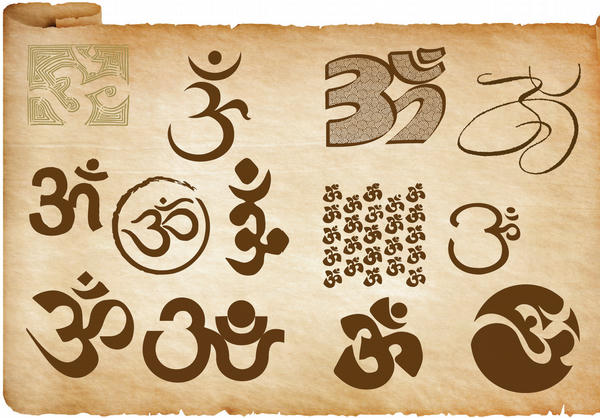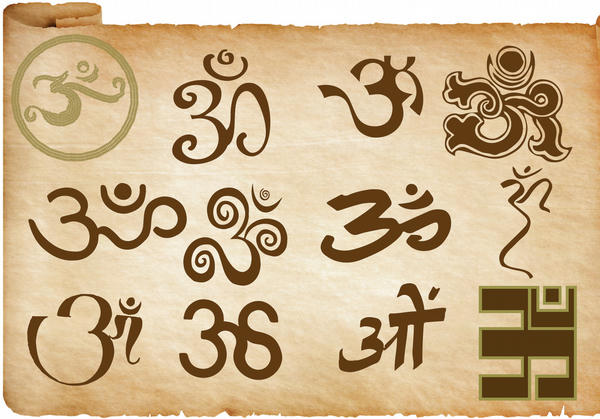Gaṇeśa as Primal Sound§
Gaṇeśaḥ Praṇavātmakaḥ§
गणेशः प्रणवात्मकः§
By Ratna Ma Navaratnam, from Oṁ Gaṇeśa: the Peace of God§
 OMAGE TO GAṆAPATI. THERE ARE MANY APPROACHES TO TRUTH. OṀ Gaṇeśa is one such approach. Here we have an attitude and spirit that can make it possible for the human race to grow together into a single family. Gaṇeśa Oṁ is efficacious because it flows from a true vision of spiritual reality.§
OMAGE TO GAṆAPATI. THERE ARE MANY APPROACHES TO TRUTH. OṀ Gaṇeśa is one such approach. Here we have an attitude and spirit that can make it possible for the human race to grow together into a single family. Gaṇeśa Oṁ is efficacious because it flows from a true vision of spiritual reality.§
In the Vedas, there are references to Gaṇapati, the lord of the gaṇas, the attendants of Śiva. That there is no difference between Lord Śiva and Gaṇapati is brought out in the Ṛg Vedic mantras recited before the great Śrī Rudram hymn from the Yajur Veda Samhita.§
Gaṇānāṁ tvā gaṇapatigṁ havāmahe
kaviṁ kavīnāmupamaśravastamam |
jyeṣṭharājaṁ brahmaṇāṁ brahmaṇaspata
ā naḥ śṛṇvannūtibhiḥsīdasādanam ||§
The Deity who is hailed as the chief of the celestial hosts (Gaṇapati) here is called Brahmaṇaspati. However, the descriptive epithets applied to Him are apposite as well to the elephant-faced God as Kaviṅkavīnām, the Seer of seers, Gaṇapati being the God of wisdom par excellence, and Jyeshṭharājam, the Vināyaka commanding precedence over others.§
Also, in verse one of the Gaṇeśa Pañcharatna by Śrīi Adi Shankara is found the reference: kalādharāvataṁsakam, “He who dons the crescent,” which attribute is also applied to Śiva.§
The Vedic seers were not only familiar with Gaṇapati worship, but they assigned Him a special place among the Gods, and He was propitiated to bestow success and enjoyment and to avert obstacles and calamities. Various prayers to Gaṇeśa are found in the Vedic texts. He is invoked as the Principal of principals:§
गणानां त्वा गणपतिगं् हवामहे कविं कवीनामुपमश्रवस्तमं ।
ज्येष्ठराजं ब्रह्मणां ब्रह्मणस्पत आ नः शृण्वन्नूतिभिः सीद सादनं ॥§
Gaṇānāṁ tvā gaṇapatigṁ havāmahe
kaviṁ kavīnāmupamaśravastamam |
jyeṣṭharājaṁ brahmaṇāṁ brahmaṇaspata
ā naḥ śṛṇvannūtibhiḥsīdasādanam ||§
O Gaṇapati, the Seer of seers, unrivalled in wealth,
King of elders, Principal of principals.
Hear us and take Thy place,
bringing with Thee all enjoyments.§
Ṛg Veda, 2.23.1§
In Śatapatha Brāhmaṇa 10.4.56, the Son of God, “a second myself,” dvitiya ātma, is spoken of as mithuna: the “word not spoken.” God’s unspoken word is internal and unmanifest. Gaṇeśa thus came to be recognized as the “God Word.” The Son is the testimony of the immanence of God being generated eternally. Gaṇeśa reflects the wisdom of His Father and is the repository of the word of God.§
In the Taittirīya Āraṇyaka is a clear reference to Gaṇapati as Dantim (tusker). This word occurs in the Gāyatrī sacred to Gaṇapati:§
Tanno dantiḥ pracodayāt.
Let that Tusker illumine our thoughts.§
In the beginning is the Word. That Word is Aum, and the resonance of Aum is heard everywhere. Aum Tat Sat. That is what It is. So declare the Vedāgamas.§
That word is Aum. This syllable is the imperishable spirit,§
This indeed is the highest end. Knowing this syllable, truly indeed,§
Whatsoever one desires will be his.… That is the Supreme Support,§
Knowing that support, One becomes happy in the Brahma world.§
Kaṭha Upanishad 2.15-16§
This audible symbol Aum serves as a support of contemplation.
One infers the unseen in the seen, the unheard in the heard.§
Dr. Ananda Coomaraswamy§
We sing in praise of Him
Who is the essence of Omkāram.§
Satguru Yogaswami’s Natchintanai§
The Causal Word, Aum, represents the divine thought, the source of existence. It corresponds to the power of will, known as Śiva Intention, or icçhā śakti. The power of knowledge known as Vishṇu Formulation, or jñāna śakti, and the power of action known as Brahmā Expression, or kriyā śakti, also express the Causal Word, Aum.§
Omkāra signifies the Supreme Śivam, being both vyashṭi (individual) and samashṭi (cosmic). Thus, Gaṇeśa Aum, the divine son of Śiva, is the support of the whole universe. His sound-symbol Aum is indestructible in past, present and future. It is immortal and ageless. He is ever Pillaiyar, the cherished child of Umā-Parameśvara. By meditating on Him in the three aspects of A-U-M, devotees can realize the reality of the Godhead. The mahāvākya Aum Tat Sat implies “That is what it is,” and it is transmuted into the form of Gaṇeśa. He embodies the Truth of Tat Tvam Asi, “Thou art That.”§
Everything that our mind can grasp can be expressed in terms of kind or category. So, category is a fundamental element of existence. All that can be counted or comprehended is a category (gaṇa). The principle of classifications through which the relations can be understood between different orders of things, between the macrocosm and the microcosm, is called the Lord of Categories. He is Gaṇapati.§
Mahāgaṇapati is the ruler of all the categories and can be identified with Divinity in its perceptible manifestation. He guards the first approach to life and all its manifold unfoldment.§
I bow to you Gaṇapati, Lord of categories.
You along are the visible form of the principle of All, the
true Self. O Lord of categories, Thou art the Lord. Here us
and take thy place and bring with thee all enjoyments.§
Ṛg Veda, 2.31.1§
The principle of categories transcends intellect. As the Lord of categories, Gaṇapati rules over the universal intellect and the principles of the elements (tattvas) derived from it.§
It is noteworthy that Gaṇapati is sometimes identified with Bṛihaspati, the patron of letters. Mythologically, He is the scribe who writes down the scriptures. He figures as the scribe of Sage Vyāsa, the author of the Mahābhārata.§
You, leader of categories,
are the writer of this Mahābhārata.§
Mahābhārata 1.1.77§
Microcosm and Macrocosm§
Gaṇeśa also stands for one of the basic concepts of Hindu mythological symbolism—the identity of the macrocosm and the microcosm. In our religious tradition, the remembrance of the divinity of man and the immanence of God must be present before the doer of any action. In this way a Hindu learns to bow to Gaṇeśa at every turn. Not only is He worshiped at the beginning of every undertaking, but He guards the entrance of every house, of every temple and business establishment in the land of the Hindus. Aum Gaṇeśa is what He is: the master guide of devotees to realize their Divinity.§
The identity of the macrocosm and the microcosm can be observed in the permanence of the relations formed as the substratum of all the aspects of the perceptible universe. Pillaiyar, as he is fondly called by the Śaivites, is represented as elephant-headed to express the unity of the small being, the microcosm that is man, and the great being, the macrocosm, pictured as an elephant. The word Gaja, meaning elephant, is taken to mean “the origin and the goal.” The stage reached by the reintegrated being, the yogī, in his experience of ultimate identification (samādhi) is called Ga, the goal; and the principle called Ja, the origin, is that from which the syllable AUM is said to be issued through a process of multifold reflection.§
The man-part of Gaṇapati, representing the manifest principle, is subordinate to the unmanifest, shown as the elephant, which is the head. In symbols depicting Divinity, opposites can coexist. Hence man and elephant are combined in Gaṇapati’s symbol, which leads to its essential meaning of Praṇava.§
The elephant is also a symbol of the stage whence existence begins (Brahmasūtra 1.1.4) and whence the syllable Aum issues. From Aum issues the Veda, the universal law, and from the Veda, the universe. Prāṇa is the life current, and Va is the energy of Śiva named Chit Śakti. When they mingle in the vibration of Prāṇa-Va, Gaṇeśa reveals Himself. Aum Tat Sat Aum is His sacred message. The living beings are the visible form of That, the Supreme Reality. Human existence denotes the coordination of the Absolute and the relative, of That and Thou.§
That (Tat) represents the limitless, transcendent
principle whose (nature) is Truth and Knowledge.Ӥ
Taittirīya Āraṇyaka 8.1.1§
The Letters of Aum§
True knowledge is the realization of this unity which Gaṇeśa signifies. Aum is commonly attributed to the form of Gaṇeśa, the Lord of the Praṇava Mantra, even though the three letters A-U-M signify a number of God’s names when taken separately. A stands for Virat, Agni and Viśva. U stands for Hiraṇyagarbha, Vāyu and Taijasa. M represents Īśvara, Āditya and Prajña.§
Virat is the all-comprehensive universe of being. Agni is the primary element of all sacrificial ceremonies. Viśva means God Śiva, since the whole universe and the objects in the universe are manifested and are sheltered in Him. He pervades all of them.§
Hiraṇyagarbha is One who is the source and support of all light and luminous bodies as the sun, moon and stars. Vāyu means one who is the life and support of the universe, the cause of its dissolution. Taijasa is one who is resplendent and gives light to the Sun and other luminous bodies.§
Īśvara is one whose knowledge and power are infinite. Āditya means immortal. Prajña denotes one whose knowledge is perfect and one who is omniscient.§
Thus, the sacred syllable Aum combines within itself some of the most sublime names of the Supreme Being, and connotes His omnipotent and omniscient nature and attributes. Aum thus represents, in its fullest connotation, God, the Supreme Being.§
Akṣaram Brahma Paramam
Svabhavo Adhyātmamucyate.§
Bhagavad Gītā 8.3§
Brahman is spoken of as Akshara: that which is imperishable and inexhaustible. Saint Auvaiyar also referred to Akshara, meaning eternal wisdom, in her famous poem on Vināyaka.§
Kṛishṇa tells Arjuna in the following verse that he who leaves the body reflecting on Aum reaches the goal of beatific bliss, Paramam gatim.§
Oṁ Ityekākṣaram Brahma
Vyāharan mām anusmaran
Yaḥ prayāti tyajan deham
Sa yāti paramām gatim.§
Bhagavad Gītā 8.13§
Aum is the Ekākshara, the one-lettered mantra of the Paraśivam, the word not spoken. Mantra is that which redeems when contemplated upon:§
Mananāt thrāyate itimantra.§
The Son of Śiva, Gaṇeśa, being “a second myself,” came
to be recognized as the God Word Aum.§
When we chant the Praṇava Aum—the harmonious combination of the three basic sounds, akara, ukara and makara—the microcosmic activity links with the entire macrocosmic activity of the cosmos, which represents the all-pervading Reality of Paraśiva.§
Akāra sound is produced from the base of the spinal cord, where the kuṇḍalinī is posited, and rises to the throat. The supreme consciousness (chaitanya), functioning through the gross body in the waking state in the individual, is called vaiśvānara and is represented by the first syllable, A.§
Ukāra is the second stage, where the sound from the throat is rolled outwards to the tip of the tongue. The same supreme consciousness, functioning through the subtle body in the dream state in the individual, is called taijasa, and is represented by the second syllable, U.§
Makāra sound is concentrated at the lips. This same supreme consciousness, functioning through the causal body in the deep sleep state in the individual, is called prajña, and is represented by the final syllable, M, in AUM.§
The significance of the Aum mantra is also brought out lucidly in the sīkshāvalli of the Taittirīya Upanishad:§
Oṁ iti brahma, Oṁ itīdaṁ sarvam
Oṁ ityetad anukṛti, Oṁ iti sāmāni gāyanti (1.8).§
And in the Çhandogya Upanishad:§
Oṁ ityetadakṣaram udgītham upāsīta
Oṁ iti hyudgāyati tasyopa vyākhyānam (1.1.1).§
The image of Gaṇapati and His mantra Aum constantly remind us of the reality of the great identity. Man truly is the image of the cosmos. All realization lies within himself. Through the study of his inner impulses and of his inner structure, he can understand the nature of the universe. Lord Vighneśvara assures the freedom from fear. He instills the knowledge necessary to remove the fear inherent in time and duration. What power lies hidden in the mystic Aum, the sound symbol of Gaṇapati, and which is uttered at the beginning of every rite! Its meaning is expressed in Aum Tat Sat and represents the fundamental identity of the macrocosm and the microcosm.§
Aum Symbols of Gaṇeśa§
The swastika forms the graphic symbol of Gaṇapati. It is represented by a cross, being the development of the multiple from the basic unity, the central point; but each of its branches is bent so that it does not aim at the center. This is intended to show that man cannot reach the basic unity directly through the outward forms of the universe.§
Gaṇeśa’s trunk is bent because Divinity cannot be directly understood and also because He is master of obstacles. The noose in His hand destroys moha, delusion, the enemy of all seekers. The driving hook is the insignia of the ruler of the universe. The hand granting boons fulfills all desires, and the other hand allays all fears. Man seeks Gaṇeśa’s protection at every turn in order that the Great Being may establish Itself in his midst, and he may become one with It.§
That Transcendental One is Aum Gaṇeśa. That Immanent One is Aum Gaṇeśa. The living beings are Gaṇeśa Aum. Thus do we raise the chant of concord, Aum Gaṇeśa Tat Sat Aum.§
A Graphic Collection of Thirty-Seven Aums§
On the following pages the editors of Loving Gaṇeśa have assembled a special collection of Aum calligraphy gathered at our Kauai monastery over the past few years. They are mostly drawn in Devanāgarī, but also in some of India’s regional scripts. Of all the sacred symbols from India’s rich spiritual heritage, none is more widely used and loved than the Aum. It is Divinity incarnate, and so it is natural that calligraphers and artists, designers and wall painters use it again and again to express the highest Truth.§
We take great joy in sharing our world-class collection of Aums (and other Indian art forms, like Gaṇeśas, village artistry and more). Now the entire collection has been indexed and made available to everyone through HAMSA, the Himalayan Academy Museum of Spiritual Art. In Sanskrit, hamsa names the Indian goose (Anser indicus) or a swan. It represents the Ultimate Reality and the spiritually pure soul. The flight of the hamsa symbolizes moksha—the release from samsara, the cycle of birth, death and rebirth, and the start of our soul’s continued evolution in the inner worlds.§
Indian spiritual art has no equal in the world for scope, sheer quantity, devotion and philosophical significance. To peruse (and download) the thousands of images available at HAMSA, go to www.himalayanacademy.com/hamsa. In addition to hundreds of Aums, you will find rare masterpieces, sacred religious symbols, illustrated alphabets, decorative borders, educational depictions of Hindu Deities, culture, philosophy, legend, children’s stories, and much, much more.§
